Mixing fun with policy-making to improve the breed
By Jerry Thoms
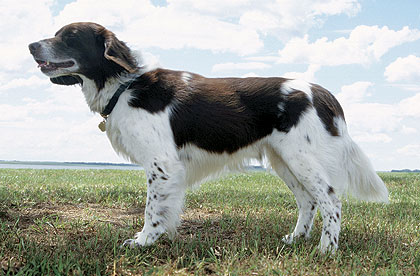 The Small Munsterlander, though a pointer first and foremost, is a "versatile" gun dog of German origins bred to track and retrieve game as well as furred animals. |
Summer can be downtime for many gun dog owners and breed club members. But for the Small Munsterlander Club of America, summertime, outside of the hunting season, is the busiest time of the year.
Summer is when the Small Munsterlander breed club members get together for a national meeting. Sixty some Small Munsterlander owners will gather for three days to work on club policies, to learn about and train dogs and to have a just-for-fun hunting contest.
"In the seven years of the Munsterlander Club's existence, we have had six of these get-togethers in some centrally located, upper-Midwestern state," reports Tom McDonald, the club's past president from Lincoln, Nebraska.
"The annual national meeting of the Small Munsterlander Club of America has been a particularly good thing for the dogs," McDonald says. "In the last several years, club members and their Munsterlanders have attended from all across the country. The usual format is to have a day of business meetings where we develop club policies on breeding and testing practices and any other related subjects. The rest of the time is devoted to learning activities such as lectures in canine breeding, genetics and health care, as well as testing for canine good behavior and training for hunting.
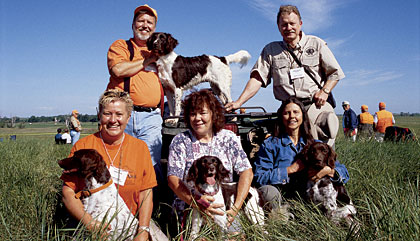 The Small Munsterlander Club of America has grown from 20 members in 1998 to more than 60 today with an annual meeting held each year in Nebraska, South Dakota, Wisconsin or some other upper-Midwest state. |
"One of the features of our annual meeting is that all the members gather in person to have face-to-face discussions about such subjects as breeding policies, canine health issues and testing programs. For example, we have discussed the prospects of including the North American Versatile Hunting Dog Association's 'utility test' to go along with the 'natural ability' test we already now use in qualifying our dogs for our club's breeding program. Likewise, there have been some useful debates on how to sanction any breeders who have dogs with serious genetic defects," McDonald adds.
"As with any breed club, our Munsterlander organization has its share of divisive political issues, occasional conflicting personalities and real differences of opinion," notes Kris Hill, one-time club president from Nebraska. "But all our members are united by a desire to improve the breed and to enjoy our dogs as hunters and companions. Doing this is a lot easier in an actual meeting than trying to do something long distance by email or telephone."
A Hunt For Chukars
"One highlight of the annual meeting is a just-for-fun hunting contest where we use our dogs to find, point and retrieve pen-raised and released quail, pheasants or chukar partridge. Though there is an element of competition in the contest, most participants are doing this for the joy of hunting with their dogs," says McDonald.
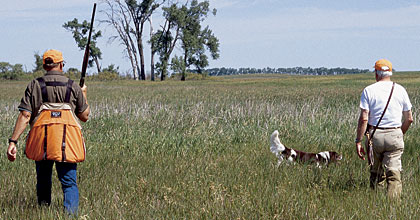 In the chukar hunt, two judges follow a hunter and his dog through a 10-acre field of prairie grass where pen-raised chukars have been released. The dog owner has the option of having a designated gunner (as in this case) so the dog can receive more handling attention. |
"The Munsterlander hunting contest was actually a combination of fun hunting mixed in with some informal dog training," says John Luttrell, head dog trainer and operations manager at Oak Tree Hunting Lodge and Training Facility in Clark, South Dakota, the location of the most recent three-day Small Munsterlander convention.
"Because our hunting preserve season runs from September 1 to March 31, we couldn't release pheasants for the Munsterlander event. So we used chukar partridge, which in South Dakota are not legally considered native game birds," Luttrell explains.
"Using what are now pretty much standard upland game bird hunting competition guidelines, we put these pen-raised chukars into marked-off 10-acre plots of native prairie grass," Luttrell says. "There each hunter and dog team were given 30 minutes to locate, point, flush, shoot and retrieve a maximum of three partridge with qualified judges scoring the teams."
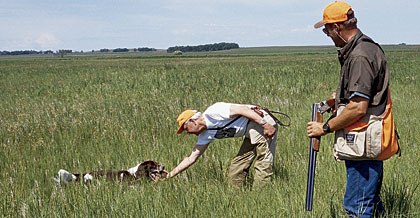 One of the major traits of the Small Munsterlander is its strong tracking and retrieving instinct, something that ensures the recovery of wounded and dead birds that fall in heavy cover. |
"Some teams did real well and some needed more practice, but everyone had a good time," says Dr. Gene Kluck, a Watertown, South Dakota, veterinarian, German wirehaired pointer owner and one of the volunteer judges for the Munsterlander chukar hunt. "When I was asked to judge this event, I was at first a little hesitant because a mid-summer hunt for pen-raised partridge didn't sound like a promising idea," Kluck admits.
"The birds, however, were good fliers in addition to sometimes running ahead of the dogs and eventually holding real well to be pointed. Many of the Munsterlanders had never seen chukars, but most of the dogs recognized and treated them as any other game bird and did good work following, finding, pointing and fetching the birds.
"At the end of the chukar hunt, we gathered up the birds and cleaned them, then grilled them for a noon lunch," Kluck recollects. "We cooked the chukars along with beef burgers just in case anyone didn't want to eat partridge. But one taste of the game meat and it was all gone in a couple minutes. That sure added a lot to the hunting experience."
Canine Good Citizen Test
Another regular event of the Small Munsterlander annual meeting is the "Canine Good Citizen Test," a 10-point examination of acceptable "good" dog behavior in a variety of social settings. The test, a formal procedure devised by the American Kennel Club, is designed to evaluate any breed of dog according to its ability to calml
y interact with human strangers and the presence of other dogs without lapsing into any form of disruptive or unruly behavior.
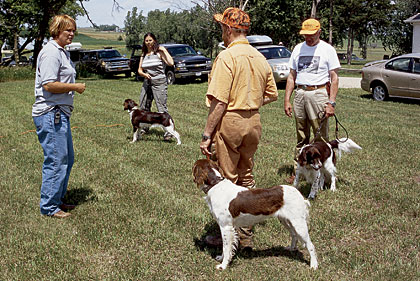 The Canine Good Citizen Test, a regular event during the Small Munsterlander national convention, evaluates a dog's trainability, temperament and cooperation in a social situation involving people and other canines. |
The test includes having the dog walk through a crowd of people and confront other dogs, sit and stay on command, directly react to distractions and sit and stay when left alone. In addition, the test administrator will examine the dog's ears, mouth and feet, looking for friendly cooperation and calm temperament. Any growling or snapping at any stage of the test will disqualify the dog from the testing program.
"All this sounds pretty simple. But to pass the test, time and effort in training are necessary," says Debra Krsnich, the Canine Good Citizen Test coordinator and head evaluator for the Small Munsterlander Club. "About half the dogs fail the first time through because they have to pass each of the 10 steps in the testing program. Any dog that fails the first time can be re-tested as many times as necessary after some re-training," Krsnich explains.
"The CGC Test goes beyond just seeing if a dog has acceptable social behavior," adds Dean Rasmussen, a Small Munsterlander Club member from Clark, South Dakota. "When you watch any Munsterlander take this test, you will learn a lot about each dog's trainability, temperament and cooperation. All these factors are important considerations when making decisions about breeding my dogs to anyone else's dog."
"One reason we get such a good turnout for our annual meeting is that we have done a good job of mixing business with pleasure," says Bev Turner, newly elected president of the Small Munsterlander Club. "Our sessions on club policy issues, along with the seminars and lectures, are pretty serious. But when we're done, we have fun training our dogs and, of course, a good time hunting with them in the contest."
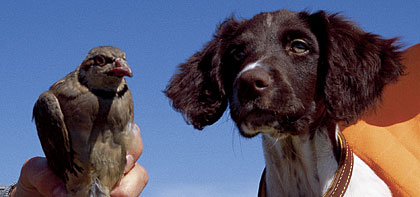 Only a few of the Small Munsterlanders in the chukar hunt had ever seen pen-raised partridge. A majority of the dogs in the hunting-contest-training-session, however, after being introduced to the birds, did a good job of finding, pointing and retrieving the birds in thick stands of prairie grass. |
"Building and maintaining a membership are both key components in establishing a national club for any breed of gun dog," Tom McDonald feels. "What we have here isn't perfect, but every year our membership has increased and the interest in owning and breeding Small Munsterlanders certainly is growing. Because of our club, more good litters of pups are available, more young and adult dogs are being tested in NAVHDA and more of our breed is found hunting game birds every hunting season all across the country."
For more information on the Small Munsterlander Club of America or on organizing a national meeting according to the SMCA model, call Bev Turner at 402-625-2626 or e-mail her at 65610@alltel.net.






